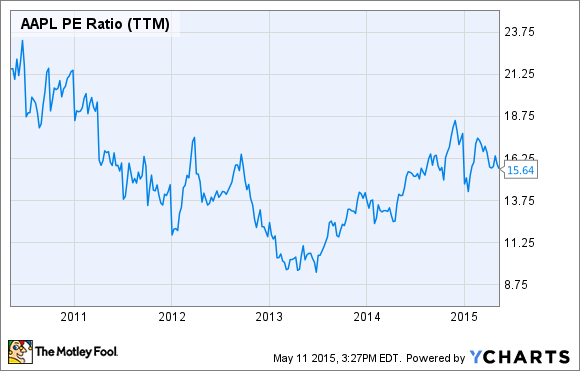Apple (AAPL -0.57%) reported a monster quarter on April 27. The technology behemoth blew analyst estimates out of the water, thanks to the massive success of the iPhone 6 and iPhone 6 Plus.

iPhone 6 and iPhone 6 Plus. Photo: Apple
In response, many analysts immediately increased their price targets for the stock. According to Thomson Financial, the median price target for Apple is now $150 per share, with the highest target at $195.
Even famous investor Carl Icahn weighed in shortly after Apple's earnings, saying the stock was still massively undervalued. Back in February, Icahn said he believed Apple was worth $216 per share, which translates to a $1.3 trillion market capitalization.
And yet shares of Apple have declined about 6% since its huge earnings report. It seems that opinion is unanimous that Apple is undervalued. The problem is, the last time sentiment was so overwhelmingly positive, Apple shares crashed.
Cheapness is in the eye of the beholder
Last quarter, Apple's revenue and earnings per share soared 27% and 40% year over year, respectively. Apple is fresh off a monster quarter, thanks to the newest version of the iPhone. This has prompted many investors and analysts to proclaim that Apple stock is a steal.
With these growth rates, it's nearly impossible to find an analyst or investor who doesn't think Apple is cheap. Indeed, Apple trades for 15 times earnings, which looks cheap because the S&P 500 Index trades for about 20 times earnings. Since Apple is growing at such high rates, it seems ludicrous that this stock would not command a higher multiple.
But there could be a reason for its apparent cheapness, which is that future growth may taper off, just as it did after the iPhone 5. It could have easily been argued that Apple was cheap in September 2012, when the stock traded for just 15 times earnings. But that didn't stop the stock's multiple from contracting to 9 times earnings the following year.
AAPL P/E Ratio (TTM) data by YCharts
Analysts currently expect Apple to generate 7% earnings growth in the next fiscal year. That's a respectable growth number, and would still probably be higher growth than the S&P 500 as a whole. Apple is cheap compared to the broader market, but it's not nearly as cheap when compared to its own historical average valuation multiples. And, if Apple can't meet expectations next year, analysts will be caught off guard -- a scenario that investors have seen before.
Beware the lull
Back in 2012 and 2013, Apple was in a nearly identical position as it is now. The company had a hit on its hands with a new iPhone, and registered massive growth thanks to the product refresh cycle. The problem was that analysts and investors soon turned their attention from the past to the future. Once the iPhone 5 became saturated, competition intensified, margins contracted as Apple spent heavily on developing its new products, and growth flat-lined.
Apple is going to face extremely difficult comparisons next year. As a result, it's going to be very difficult for Apple to grow earnings. Add to this the uncertainty surrounding Apple's biggest new product, the Apple Watch, and it's far from a guarantee that Apple will produce enough growth next year to justify a higher multiple.
After Apple hit the equivalent of $100 per share in 2012 based on excitement about the iPhone 5, analysts failed to properly forecast what would happen in subsequent quarters. For example, analysts expected Apple to earn a pre-split $15.49 in Q1 of fiscal 2013 before Apple gave its initial guidance. Apple's earnings ultimately came in more than 10% below this forecast.
Analysts were also slow to adjust their forecasts for the rest of the year, which eventually had to be cut. This was the catalyst behind Apple losing nearly half its value from the 2012 peak to the 2013 low.
Apple could still be a long-term winner. After all, it has a proven track record of being able to continue innovating even after a massively successful new iPhone launch. But Apple's 2012-2013 experience still had a very real effect.
The post-new iPhone lull set the stage for Apple's big decline last time. I'm not suggesting Apple will lose half its value as it did then. But sentiment can quickly change if Apple's growth doesn't meet expectations. If growth levels off, multiple contraction usually follows. This begs the question whether Apple stock is truly as cheap as it seems.






